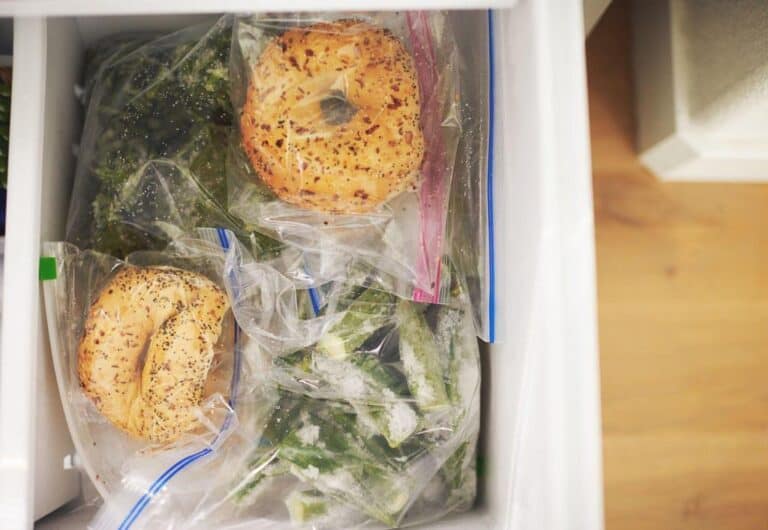How to Defrost Frozen Dough Quickly Without Sacrificing Quality or Taste

Frozen dough is a convenient way to keep your favorite baked goods on hand, from bread to pizza dough to cookie dough. If you’re an avid baker, you know the joy of having a batch of homemade dough ready to go in the freezer.
But when it comes time to use the dough, it can be a hassle to defrost it properly. If not done correctly, defrosting can lead to uneven or inconsistent results, such as dough that is too wet or dry, or bread that doesn’t rise properly.
You don’t want to sacrifice the quality or taste of your dough, but you also don’t have hours to wait for it to thaw. Fortunately, there are a few tricks you can use to defrost frozen dough quickly and without compromising its quality.
In this article, we will explore some simple and effective ways to defrost frozen dough without sacrificing quality or taste.
Why Proper Defrosting is Important
Defrosting frozen dough properly is essential for ensuring that the dough is of good quality and safe to eat. When frozen dough is thawed too quickly, the outside can become mushy while the inside remains frozen, which can cause uneven rising and baking. Additionally, if dough is left at room temperature for too long during defrosting, it can become a breeding ground for harmful bacteria that can cause foodborne illness.
Four Methods for Defrosting Frozen Dough
There are three main methods for defrosting frozen dough: in the refrigerator, at room temperature, and in the microwave. Each method has its pros and cons, and the best option depends on the type of dough you’re working with and your timeline.
1. Defrosting in the Refrigerator
Defrosting frozen dough in the refrigerator is the safest and most reliable method. It allows for slow, even thawing and minimizes the risk of bacterial growth. Here’s how to do it:
- Remove the dough from the freezer and place it in a bowl or on a plate.
- Cover the dough with plastic wrap or a clean kitchen towel to prevent it from drying out.
- Place the dough in the refrigerator and let it thaw overnight. For larger batches of dough, it may take up to 24 hours to thaw completely.
Once the dough is completely thawed, it can be used immediately or stored in the refrigerator for up to three days.
2. Defrosting at Room Temperature
Defrosting frozen dough at room temperature is the quickest method but also the riskiest. It can lead to uneven defrosting and bacterial growth if not done correctly.
Here’s how to do it:
- Remove the dough from the freezer and place it on a clean kitchen towel or plate.
- Leave the dough at room temperature for 2-3 hours, or until completely thawed. Make sure to check the dough every 30 minutes and rotate it if needed to ensure even defrosting.
It is important to note that this method should only be used if you plan to use the dough immediately. If you do not plan to use the dough right away, it should be defrosted in the refrigerator to minimize the risk of bacterial growth.
3. Defrosting in Cold Water
Defrosting in cold water is a quick and easy method for defrosting frozen dough that does not require a microwave. However, this method requires constant attention and cannot be left unattended.
To defrost dough using this method, follow these steps:
- Place the frozen dough in a sealed plastic bag, removing as much air as possible.
- Fill a large bowl with cold water and submerge the dough in the water.
- Change the water every 30 minutes until the dough is completely thawed. This process usually takes around 1-2 hours, depending on the size of the dough.
4. Defrosting in Warm Water
Defrosting in warm water is not recommended as it can cause the dough to start to cook, leading to a change in texture and flavor. However, if you’re in a rush and need to defrost your dough quickly, this method can be used with caution.
To defrost dough using this method, follow these steps:
- Place the frozen dough in a sealed plastic bag, removing as much air as possible.
- Fill a large bowl with warm water (not hot) and submerge the dough in the water.
- Change the water every 10-15 minutes until the dough is completely thawed. This process usually takes around 30 minutes to an hour.
Note: Be cautious not to use hot water as it can start to cook the dough and affect the texture and flavor.
How to Defrost Frozen Dough Quickly Without Sacrificing Quality or Taste
Defrosting frozen dough in the microwave is the fastest method, but also the most challenging. Microwaving frozen cookie dough can lead to uneven defrosting and cause the dough to become rubbery or tough.
Here’s how to do it:
- Place the frozen dough in a microwave-safe dish.
- Set the microwave to the defrost setting or 30% power.
- Microwave the dough for 1-2 minutes, or until it is soft enough to work with.
- Be sure not to overdo it, as microwaving for too long can cook the dough in some spots and leave others frozen.
- This method is best used for smaller portions of dough, as larger portions may not defrost evenly.
It is important to check the dough frequently while microwaving it to ensure that it does not become too hot or begin to cook. Once the dough is soft enough to work with, it should be removed from the microwave and allowed to finish thawing at room temperature.
Tips for Defrosting Frozen Dough
Now that you know the three best methods for defrosting frozen dough quickly, here are a few tips to ensure that your dough comes out perfectly:
- Plan ahead: If you know you’ll need frozen dough for a recipe, be sure to take it out of the freezer and place it in the fridge to thaw overnight.
- Use the right container: When freezing dough, use a container that is airtight and freezer-safe. This will prevent freezer burn and help to maintain the quality of the dough.
- Label your dough: When freezing dough, label the container with the date and type of dough. This will help you keep track of what’s in your freezer and ensure that you use the dough before it goes bad.
- Don’t rush the process: While it can be tempting to use a microwave or hot water to thaw frozen bread dough at room temperature quickly, it’s important not to rush the process. Taking the time to thaw the dough slowly will ensure that it comes out perfectly.
- Let the dough rest: After defrosting the dough, let it rest for a few minutes before using it to make bread. This will give the yeast cells time to activate and the dough time to become pliable.
Troubleshooting Common Issues with Defrosting Frozen Dough
Defrosting frozen dough can sometimes be a tricky process, and even with the best methods and intentions, issues can arise. Here are some common issues that people may face when defrosting frozen dough and how to troubleshoot them.
One common issue is that the dough may become too wet or sticky after defrosting. This can be due to excess moisture forming on the surface of the dough during the thawing process. To prevent this, be sure to wrap the dough tightly in plastic wrap before freezing it, and avoid leaving any gaps where moisture can enter. If the dough is already wet after defrosting, add a little flour and knead it in until the dough is smooth and no longer sticky.
Another issue is that the dough may not rise properly after defrosting. This can be caused by the yeast in the dough being damaged during the freezing process. To prevent this, try using a higher quantity of yeast when making the dough, or using a specific type of yeast that is more resilient to freezing. If the dough has already been defrosted but doesn’t seem to be rising, try letting it sit at room temperature for a little while longer to see if it needs more time to activate.
If the dough has developed an off or unusual smell after defrosting, it may have been stored for too long or at an improper temperature. It’s important to always freeze dough as soon as possible after making it, and to ensure that the temperature of the freezer is set to the recommended level for frozen dough. If the dough has been stored for a long time, it may be best to discard it and start fresh to avoid any potential health risks.
Lastly, it’s important to note that different types of dough may require different defrosting methods or timeframes. For example, bread dough may require longer to defrost than pizza dough due to its larger size and denser texture. Always refer to the specific instructions for the type of dough you are defrosting to ensure the best results.
Overall, defrosting frozen dough can be a delicate process, but with careful attention and troubleshooting, most issues can be resolved. Remember to take your time and be patient, and always prioritize the quality and safety of your dough.
Conclusion
In conclusion, defrosting frozen dough properly is crucial for ensuring quality and taste. By following the methods outlined in this article, you can safely and effectively defrost your dough without sacrificing its quality. Whether you prefer the safe and slow method of defrosting in the refrigerator or the quick method of defrosting in the microwave, always remember to take care to avoid any unwanted changes in texture






